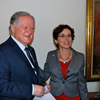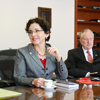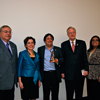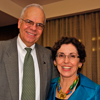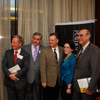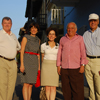President France A. Córdova
Presentation to Faculty Senate
Monday, March 19, 2012
Purdue Memorial Union
One of the goals of the University’s Strategic Plan, approved nearly five years ago, was “Meeting Global Challenges,” This goal was taken up by our colleges in their more specific strategic plans. For example, for the college of Engineering this goal took the form of “Extraordinary People, Global Impact.”
Figuring out how to accomplish the goal of global impact has had a transformative change on many of our Purdue faculty and students. In the past few years we have seen significant outreach to all corners of our ‘flat’ world – Beijing, Hong Kong, Taiwan, Singapore, India, Russia, Ethiopia, Afghanistan. In these places and more Purdue has put down firm roots, and this is bearing unusual fruit. What Purdue is effecting abroad, through the efforts of our faculty, and with the energy of our students, is revolutionary in character and substance. It is global with a distinctive Purdue stamp.
As an illustration, I’d like to share with you my first-hand experience traveling with our faculty in Colombia earlier this month. While I speak, a continuous set of slides from our trip will be projected for your viewing pleasure. The photos are those of Kirk Cerny, director of our alumni association, and Spencer Deery, aide de camp and Spanish speaker, both of whom were on this trip. You will see faculty you recognize: David Janes from ECE, Morry Levy and his wife Maria, both from biological sciences, Arvin Raman from ME, Jean Paul Allain from nuclear engineering, Arden Bement, director GPRI, Leah Jamieson, dean of the college of engineering, and Gerry McCartney, our Chief Information Officer. And you’ll see the facilitator of this trip, Juan Ernesto de Bedout, an enthusiastic and supportive member of the Engineering Advisory Council. You won’t see Bud Weiser, dean of Liberal Arts, because he came a week later with his faculty and staff. You won’t see our 15 students who spent their Spring Break there, as they came to work with EPICS staff after I and our photographers departed.
We spent several days visiting with elected officials, university officials, business people and alumni, in three major cities: Medellin, Bogota and Cartagena. The Levys spent time in the under-developed Choco region of the country. Through our many meetings, we gave visibility and substance to the Colombia Purdue Institute for Advanced Scientific Research. The aims of this collaboration are to leverage our assets for mutual benefit. For Colombia this is about accelerating economic development and helping to alleviate societal challenges through science and technology. For Purdue, this collaboration creates new research, educational and economic opportunities.
Today we have partnerships with more than 20 Colombian universities, six centers of excellence, the Colombian government and the private sector, as well as the U.S. Department of State.
The goals of our engagement are:
* capacity building (this can happen in two ways: PhD candidates from Colombia are already coming to Purdue in S&T areas, and Dean Weiser envisions they may also come for Spanish language and linguistics. In addition, faculty from Purdue, could help faculty in Colombia develop their own skills in situ and develop PhD programs there.);
* biodiversity research (this is done in locations of unique plant and microbial diversity);
* nanotechnology research (we are collaborating with a prominent Colombian utility company to build a new nanotechnology center in Medellin; it is South America's first such center and it will be focused on energy, water and the environment);
* innovation (the first Purdue-Colombia Innovation Workshop will be held in Bogota in May; its subject is "University-Industry Alliance: Realizing the Opportunities of the U.S.-Colombia Free Trade Agreement")
* and service learning (we are establishing a program called Engineering Projects in Community Service, or EPICs, modeled on our own EPICS program -- as an example, we have a collaboration between the Colombian ministry of education and local universities to install solar power in rural regions).
We dedicated a Purdue-donated supercomputer at a research university; this was a much-needed piece of infrastructure which is being used now by many universities. We signed collaborative agreements with many universities.
The genesis of this trip was Professor Arvin Raman’s work on the Engineering strategic plan. He realized in 2009-10 that engagement in Colombia, where Purdue already had some roots, could have a global impact and be a differentiating factor, placing Purdue ahead of the competition. In a short time, he and his colleagues put into motion several projects, all of them relevant to addressing that country’s challenges and making the most of its natural assets. Visits of Colombian business leaders, university deans and faculty to Purdue last Fall further stimulated collaborations.
How is Purdue regarded in Colombia? It’s not every day that a university president and her colleagues are invited to meet with and hear the bold visions of both the current and past Presidents of a country transforming itself, or to discuss science, technology and education challenges and goals with Ministers, Governors and Mayors of the nation's largest cities, or to be invited to collaborate with the country's foremost universities. As a sign of how welcome Purdue is in Colombia, your president was made an adopted daughter of the State of Bolivar, and received the keys to the city of Cartagena. I would be pleased to loan them to you if you wish to visit the city…
Our Purdue contingent made the news, nearly every day; there is a hunger in the country for the benefits science and technology can bring, and an eagerness to train their own young people to enter these fields. Purdue represents the keys to a larger world of hope for the future of Latin America.
The day we left an editorial in the paper was titled, “No Solo Harvard.” It's not just about Harvard, said the writer; Purdue University is the place to go to for computer science, civil engineering, nanotechnology, and biotechnology. What struck us was that the Purdue-Colombian efforts represent true engagement that goes in both directions; this promises to have lasting value.
In less than a month the entire world will be focused on Cartagena, Colombia, because it is the site of the Summit of the Americas. Our own President Obama is scheduled to attend, as are most of the presidents of the western hemisphere nations. It is likely that they will address the grand challenges faced by this part of the world: poverty, disease, natural disasters, and energy needs, the health of the ocean and access to fresh water. The talk will be about science and engineering solutions to these challenges. In choosing to focus on Colombia, Purdue has engaged the right partner at the right time. Our faculty realized early that Purdue can be a university leader for the U.S. in the Western Hemisphere.
